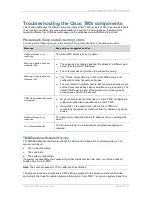
Support for remote systems
Cisco TMS Administration Guide
Page 15 of 37
Support for remote systems
From Cisco TMS 11.5, remote systems are supported for booking, getting software upgrades,
receiving phonebook and being part of the statistics created in Cisco TMS. The following section
describes how this feature works and answers some frequently asked questions.
Cisco recommends that the remote system is on a DNS compatible network to ensure proper
communication between Cisco TMS and the remote system.
Before you can use a system as a remote system in Cisco TMS, you must be sure to have set a public
DNS address on the Cisco TMS server. This can be done in Administrative Tools > Configuration >
Network Settings in the pane Advanced Network Settings for Systems on Public Internet/Behind
Firewall. Make sure that this address is reachable from the remote system, if you enter a fully
qualified host name the remote system needs to have its DNS settings in order.
How the communication works
A remote system can either be located publically on the Internet or behind a firewall. The way Cisco
TMS communicates with these two differs slightly.
Reachable on public Internet
Having the system set to Reachable on Public Internet as System Connectivity will make Cisco TMS
communicate with the system in the same way as it does with the systems internally. (To set System
Connectivity, go to on the system in System Navigator > Connection Tab.) However, since the
system cannot contact TMS on TMS’s internal DNS name or IP address, TMS will set a different
address for the phonebook service and feedback on the endpoint. The address used is the one listed
under Administrative Tools > Configuration > Network Settings > Advanced Network Settings
for Systems on Public Internet/Behind Firewall, the field TMS Server Address (Fully Qualified
Host Name or IPv4 Address).
When the system is reachable on the public Internet, you can have TMS communicate with the system
on both HTTPS (port 443) and HTTP (port 80).
Behind firewall
Setting Behind firewall as System Connectivity will make TMS communicate with the endpoint in
much the same way as Reachable on Public Internet, except TMS will not be able to tell the endpoint
to dial and must therefore set up a route where for example a Cisco TelePresence MCU is calling to
the endpoint. All communication between the system and TMS will be HTTP over port 80 or HTTPS
over port 443.
Cisco TMS will automatically detect that a system is a SOHO system when the IP address the
endpoint reports in status.xml is different from the IP address the HTTP packets are coming from, and
the HTTP (port 80) and HTTPS (port 443) ports are closed. Cisco TMS will then set System
Connectivity to Behind Firewall.
Plugging in at remote location
When a system is plugged in at a remote location, it will contact Cisco TMS either with a register event
or a boot event depending on whether the system is already in Cisco TMS. For information on how to
add a remote system to Cisco TMS, see the section Adding a remote system to Cisco TMS.
When Cisco TMS gets this event, it will reply with an acknowledgement and ask to get three files from
the endpoint: ‘status.xml’, ‘history.xml’ and ‘configuration.xml’. It will also check whether any software
upgrade has been scheduled for the endpoint, and if so, perform this.
After 60 seconds, the system will communicate with Cisco TMS, which will set the feedback
expression on the system enabling it to send events.
Cisco TMS will also set the endpoint to contact the Cisco TMS server every 15 minutes.
This will be the heartbeat that allows for communication between the Cisco TMS server and the
remote system, and any change that is done on the remote system or in Cisco TMS will be
synchronized through this heartbeat.






























